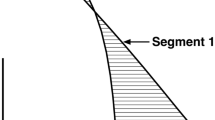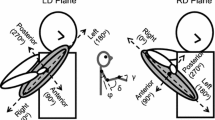Abstract
Muscle activities and joint rotations were examined at the shoulder, elbow, and wrist joints for pointing movements to targets in the horizontal plane. In such movements, multiple arm configurations are possible for a given target location. Thus, starting from the same initial configuration and for the same target location in space, the joint excursions could be varied. When no constraints were placed on the final orientation of the hand, the choice of muscles initially activated at the wrist joint was consistent with a function to resist inertial effects of proximal segment motion on the wrist joint. When subjects were asked to produce different final orientations of the hand for the same target location, the initial choice of muscles at the three joints was preserved in most trials, whether wrist flexion or extension was required to reach the final hand orientation. The relative onset times of muscle activity at the different joints were also not correlated with wrist excursion. This suggests a predetermined initial selection of muscles that is related to target location, not to joint angular excursion. The fact that the required final hand orientation was nevertheless achieved suggests that the planning of these pointing movements is not a unitary process, but is comprised of two components: a fixed initial muscle selection for a given target location in space, and a selection appropriate for the required joint excursions.
Similar content being viewed by others
References
Arbib MA (1985) Schemas for the temporal organization of behavior. Hum Neurobiol 4:63–72
Brown SHC, Cooke JD (1990) Movement-related phasic muscle activation. I. Relations with temporal profile of movement. J Neurophysiol 63:455–464
Cruse H, Wischmeyer E, Bruwer M, Brockfeld P, Dress A (1990) On the cost functions for the control of the human arm movement. Biol Cybern 62:519–528
Georgopoulos AP (1988) Neural integration of movement: role of motor cortex in reaching. FASEB J 2:2849–2857
Gottlieb GL, Corcos DM, Agarwal GC (1989) Strategies for the control of single mechanical degree of freedom voluntary movements. Behav Brain Sci 12:189–210
Hasan Z, Karst GM (1989) Muscle activity for initiation of planar, two joint arm movements in different directions. Exp Brain Res 76:651–655
Hasan Z (1991) Moving a human or robot arm with many degrees of freedom: issues and ideas. In: Nadel L, Stein D (eds) 1990 Lectures in complex systems. Addison-Wesley, Redwood City, Calif., pp 225–251
Jeannerod M (1984) The timing of natural prehension movements. J Mot Behav 16:235–254
Karst GM, Hasan Z (1991) Initiation rules for planar, two joint arm movements; agonist selection for movements through the work space. J Neurophysiol 66:1579–1593
Koshland GF, Gerilovsky L, Hasan Z (1991) Activity of wrist muscles elicited during imposed or voluntary movements about the elbow joint. J Mot Behav 23:91–100
Koshland GF, Hasan Z 1993 Initial wrist muscle activity for pointing movements of the arm persists when final hand orien tation is varied (abstract). 32nd Congress of IUPS, Abstr 248.4/P
Mustard BE, Lee RG (1987) Relationship between EMG patterns and kinematic properties for flexion movements at the human wrist. Exp Brain Res 66:247–256
Smith JL, Zernicke RF (1987) Predictions for neural control based on limb dynamics. Trends Neurosci 10:123–128
Soechting JF, Flanders MF (1991) Arm movements in three di mensional space: computation, theory, and observation. Exerc Sport Sci Rev 19:389–418
Wing AM, Turton A, Frase C (1986) Grasp size and accuracy of approach in reaching. J Mot Behav 18:245–260
Zajac FE, Winters JM (1990) Modeling musculoskeletal move ment systems: joint and body segmental dynamics, muscu loskeletal actuation, and neuromuscular control. In: Winters JM, Woo SL-Y (eds) Multiple muscle systems: biomechanics and movement organization. Springer, New York, pp 121–148
Author information
Authors and Affiliations
Rights and permissions
About this article
Cite this article
Koshland, G.F., Hasan, Z. Selection of muscles for initiation of planar, three-joint arm movements with different final orientations of the hand. Exp Brain Res 98, 157–162 (1994). https://doi.org/10.1007/BF00229121
Received:
Accepted:
Issue Date:
DOI: https://doi.org/10.1007/BF00229121




